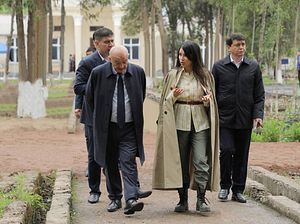President Shavkat Mirziyoyev’s eldest daughter, Saida Mirziyoyeva, took her first business trip as a government official on April 20, only eight days after her appointment as the deputy of the Agency for Information and Mass Communications. She visited Buka region, 40 miles from Tashkent, surrounded by unusually high-level officials from the president’s administration. Following the visit, she announced her trip on social media and solicited public opinion on the president’s “five initiatives,” which focuses on youth and women.
The Agency for Information and Mass Communications was created to replace a previous organization with similar functions in February 2019. It functions under the presidential administration and combines various roles of a state media policy body, regulatory body, and a media ombudsman. Its functions include a broad array of tasks, such as the development of a unified state policy on information and providing state support to the media, press, publishing services, as well as libraries; issuing media licenses and monitoring media activities; ensuring media freedom and protecting the rights of journalists.
Komil Allamjanov, who until his October 2018 sacking served as the president’s press secretary, is acting director of the agency. Because of the agency’s special status, its head automatically becomes a presidential adviser and agency deputies become deputy presidential advisers. This explains Saida Mirziyoyeva’s second title — deputy presidential adviser.
As announced, Mirziyoyeva will assume two main roles. First, she will be responsible for coordinating the activities of the press services of state bodies via the agency’s public relations center; second, she’s responsible for forming a positive image of Uzbekistan. Both of her roles will serve a single purpose that has been at the heart of most government efforts: increasing the flow of investments into Uzbekistan.
The PR center will function as an interagency body to collect information on areas in need of investment to be packaged in order to promote investments into these areas by means of business forums with foreign investors. Given this mandate, a visit highlighting a foreign investment and business success story was expected.
Instead Mirziyoyeva’s visit focused on the so-called five initiatives announced by the president earlier this year. The five initiatives focus on youth and women — the first four involve helping youth discover artistic, computer, and sports skills, as well as elicit their interest in books. The fifth initiative is slightly different, with the focus on women and ensuring their employment.
It is, of course, not clear whether the five initiatives landed on Mirziyoyeva’s desk due to the high priority placed by the president on them or if she chose to spearhead the work. Regardless, the entourage of senior officials, among them the head of the presidential administration, Zaynilobiddin Nizomiddinov, and Presidential Adviser Abdujabar Abduvakhitov, who covers science, education, health, and sports, and, as the acting presidential adviser, culture, press, and cultural organizations, indicates high stakes in the initiative.
Following her trip, Mirziyoyeva called for the implementation of the five initiatives at schools. “I would call schools the main center where the initiatives put forward by the president should be implemented,” she said. “I think that schools should be the center of culture, enlightenment, sport, and mastering computer technologies, that is, everything that underlies the five initiatives.”
Mirziyoyeva’s entrance to the public service competes the circle of President Mirziyoyev’s immediate family working for the government. Mirziyoyev’s second daughter, Shakhnoza, is also a public servant and serves as a department deputy head in the Ministry of Preschool Education. She entered the public service in 2017, but has been working under the shadow of the ministry without the social media presence her sister has already established. Both of Mirziyoyev’s sons-in-law are also in the government.
It is worth following whether the five initiatives will gain traction and proliferate beyond the presidential administration down to the Ministries of Education, Culture and Sports, Labor, the Union of Youth of Uzbekistan, and further on to the regions. It is also worth watching whether the agency’s PR center will be able to execute the hefty role of being a central hub for marketing the potential of Uzbekistan to bring much needed investments.

































